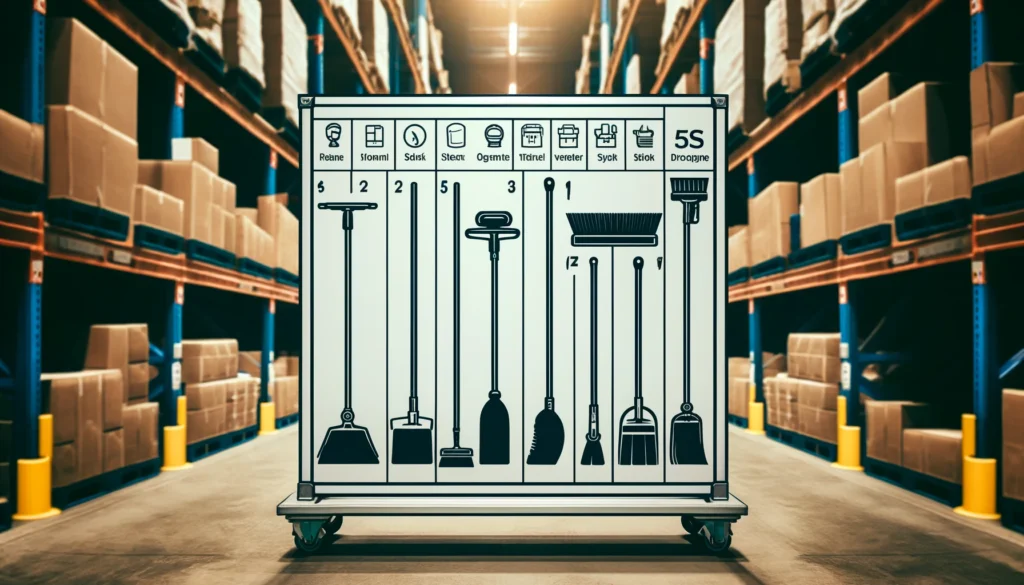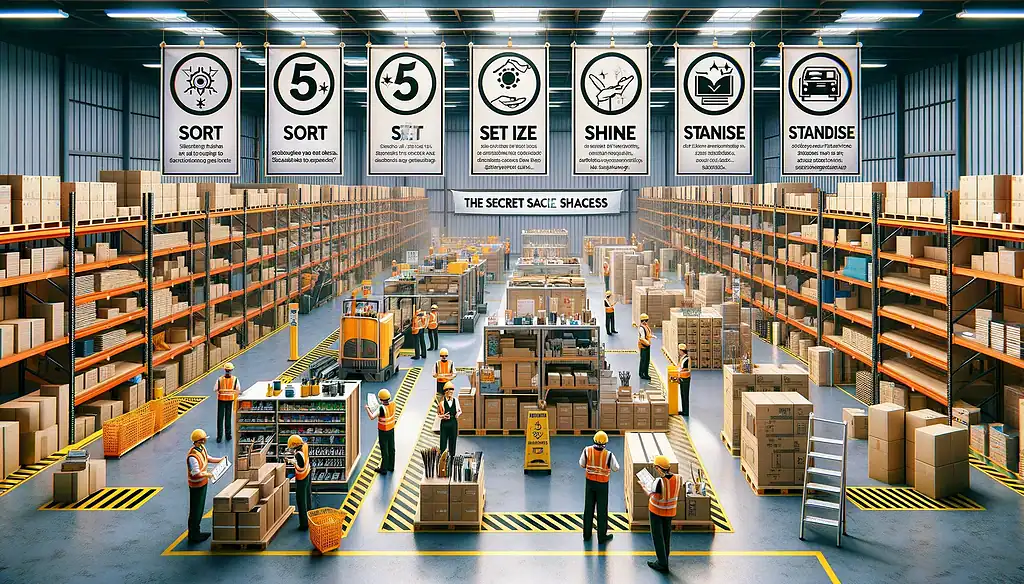5S Methodology: Perfect Your Warehouse Organization Today
Do you want to know why your 5S program is failing miserably? I’ve implemented hundreds of 5S programs in varying environments and this one thing will keep you from being successful. Read on.

“Guys: The boss is coming. We’ve got to fill up our 5S boards before we get written up. Now, where are the brooms?”
5S is a culture. It is not a program. It is not another box to check off your weekly checklist. It is not deliverable to some mid-level managers so they can get the boss off their back. 5S is like safety – either you get it or you don’t.
I asked Google what is 5S and this is what the response was:
“5S is a systematic methodology for organizing, cleaning, developing, and sustaining a productive work environment, rooted in Japanese management practices. Its advantages include improved efficiency, safety, and workplace morale by reducing waste, optimizing workflow, and establishing a sense of ownership and discipline among employees.”
Do you see the keywords in this definition? Which two words define the success or failure of your 5S program? Look again, I’ll wait.
The answer is ownership and discipline. 5S establishes a sense of ownership and discipline among employees. Let’s first discuss ownership.

What is Ownership?
If you google ownership, this is what you get:
Ownership is the legal right to possess, use, and give away something. It can refer to tangible assets, such as land and personal property, or intangible assets, such as intellectual property rights. Ownership can also refer to the quality of owning something. For example, “We owned them” means that someone defeated another team completely or performed very well.
Home Ownership
When you purchase your own home, once you get the keys, you can do anything you want with it. If you want to put up a basketball hoop in your living room, fine. If you want to combine two bedrooms into one, tear down a wall (not recommended). Don’t like the colors, paint it. It’s yours to do as you please. That is ownership.
What is Discipline?
Once again, if you google discipline, this is what you get:
Discipline is the ability to control oneself through rules, orders, or training, and to punish bad behavior. It can also refer to a way of behaving that shows a willingness to follow rules. For example, learning a foreign language requires discipline.
Home Discipline
Now that you own your own space, what are the rules that you put in place to maintain your place? Do you park you car in the same place? Do you assign a specific place to store your food? Do you dedicate one room to sleeping and one room for bathing? These are disciplines – rules that you make up to govern your space.

What is 5S?
5S is a super useful way to organize your stuff so you can find what you need quickly. Imagine you’re trying to assemble a piece of furniture in a box. The first thing in the instructions is a list of tools you need.
A lot of people skip this part and jump right into the building. But then, you’re running around looking for a screwdriver, a hammer, and even that special Allen wrench you didn’t realize was missing from the box. What was supposed to take an hour now takes three hours.
It’s like when someone puts away dishes in your kitchen, and the next thing you know, you can’t find anything. When my kids try to help at home, but everything ends up in the wrong place, it drives my wife crazy because she can’t find her stuff. Then, can’t I get in trouble for it?
5S is all about putting your things where they belong so you can spot right away if something is missing before you start doing something. It makes a ton of sense, right?
Keeping things tidy means you spend less time looking for stuff and get less annoyed. Plus, it keeps the peace at home. 5S is all about Making things easier and keeping everyone happy.
5S and Accountability
“You will put your tools and supplies where I tell you before you start your job or I will write you up.”
Does this make sense? Do you have to tell your associates how to prepare to do their jobs? Do you really think that they are intentionally trying to add time to their tasks? Sacrifice their productivity? Come on. But that is exactly what we do, and it kills 5S.
Nobody likes to be told how to do something or held accountable for rules they do not understand, specifically by their manager. And nobody knows the ins and outs of their everyday job like the person performing the work.
Why Do We Implement 5S?

Implementing 5S is beneficial for several key reasons, which align closely with its foundational goals of streamlining operations and enhancing workplace functionality:
Increased Efficiency and Productivity: By organizing the workplace and ensuring tools and materials are easily accessible, 5S reduces time wasted searching.
Improved Safety: A clean and well-organized workplace significantly reduces the risk of accidents and injuries
Enhanced Quality: 5S helps in identifying and eliminating sources of errors and defects by maintaining a clean environment.
Reduced Costs: By minimizing waste, optimizing resources, and improving efficiency, 5S can lead to significant cost savings.
Employee Satisfaction and Engagement: An organized and clean workplace improves morale and satisfaction among employees.
Customer Satisfaction: The improvements in quality, efficiency, and delivery times that result from 5S can lead to higher levels of customer satisfaction.
Foundation for Continuous Improvement: 5S sets the stage for ongoing improvements by creating a disciplined approach to workplace organization. Who’s ready for lean?
Who doesn’t want these things? Who doesn’t want to walk into a clean workspace every day? Who doesn’t want to keep themselves safe? Who doesn’t want to produce quality work? And who isn’t interested in satisfying their customers, that keep them employed?
Benefits of 5S?
The 5S program offers multiple benefits, primarily in fostering collaboration among team members around maintaining cleanliness and ensuring safety. If your organization hasn’t yet embraced teamwork among associates, implementing 5S is an excellent method to instill this practice.
5S encourages associates to take pride and ownership in their collective efforts, particularly beyond the scope of management’s direct involvement. This approach highlights the value of associates’ analytical skills over mere physical labor.
Engaging in such collaborative efforts prepares teams for further cost-saving initiatives, such as Kaizen and Value Stream Mapping, by laying a foundation of teamwork and shared objectives.
5S Secret Sauce

5S embodies more than just a methodology; it represents a culture of operational excellence and collective pride, allowing team members to display their workspace organization and shared expertise with confidence. Success in 5S comes from grassroots involvement rather than top-down mandates.
Recognizing this fundamental principle is crucial; understanding that 5S thrives on the initiative and engagement of every associate ensures its effective implementation. Without this bottom-up approach, efforts to instill 5S principles are likely to meet resistance and ultimately fall short of their potential.
Pro Tip: Implementing 5S creates an initial ‘buzz’ in your operation. Associates will question why you are spending time doing something other than pushing boxes. The reality is that this program creates ownership within the team. It re-emphasizes your cultural goals and helps make your organization A Great Place to Work.
When you foster ownership, you get personal accountability. You get peer-to-peer accountability. And you stop having to drive accountability from the top, which no one likes (let’s be honest). Who doesn’t want to work in a safe, clean, organized workplace where teams strive to improve for the right reasons?
How to Move Forward
In launching 5S, focus on thoroughly communicating its advantages, not just persuading your team to adopt the program. You’re offering them an opportunity to collectively enhance their workspace, fostering a sense of shared responsibility and ownership in the process. This approach not only promotes organization and efficiency but also leverages peer influence to naturally encourage discipline where necessary.
If you’ve already launched your 5S program, then conduct sessions with your team to discuss the end goals of the program, the benefits of the program, and then collectively make a decision whether to keep or eliminate the program on a departmental basis.
By shifting the emphasis from mere accountability in 5S to highlighting the positive outcomes for those who embrace it, you cultivate a sense of ownership among your team members. After all, ownership is universally valued. This strategic focus not only elevates engagement but also strengthens the team’s commitment to maintaining an organized, efficient, and harmonious work environment. Who doesn’t want that?






